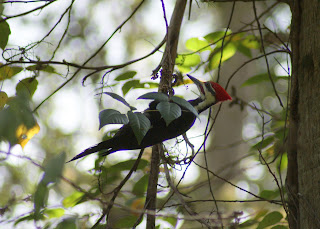Although the park had several trails to choose from, all of which traversed a slightly different type of habitat, I made a rookie mistake and wasn't able to explore many of them. As an upstate New Yorker, the last thing I thought of to bring on a hike in mid-October was bug spray. But I should have realized that mid-October in Florida, on an 85-degree day, was a completely different situation. The moment I stepped out of my car, I was completely bombarded by very hungry mosquitoes. I couldn't believe what an idiot mistake I'd made! I almost gave up right then, and got back in the car to drive the main loop instead of walking the trails on foot.
Within a couple minutes, however, I came upon two older birders, poised in the classic "I've got something" stance. I couldn't pass up the opportunity. The fantastic thing about birders, is that they are, almost without exception, very nice and welcoming people. It's the one thing that makes me able to go up to any stranger and, as long as they're holding binoculars, ask them what they're doing. So I stopped, got out of my car, and asked the couple what they were seeing. I spent about ten minutes birding that one spot with them, as there seemed to be a concentration of birds hanging around. That's the thing with birding. One patch of woods will be teeming with birdlife, while another is completely dead. Especially during fall migration, when birds tend to be more gregarious and group up, even forming mixed flocks with other species.
This time of year down here, some of the birds are still singing. I'm not used to that, as the birds fall silent much sooner up north, where breeding seasons are much shorter and winters are much harsher. Unfortunately, I'm a little out of practice with birding-by-ear, and am not used to the cocktail of species moving through the woods down here. It makes for very frustrating birding, as I know I'm not "catching" half the species that are actually present, because I just don't know what it is I'm hearing. If I don't get a good look at it, it's hopeless. And fall birds are tough to identify even by sight, as many of them are in confusing fall plumage that makes many species look alike. It's something I would really like to work on and improve at.
Anyway, with the help of the very nice couple, I managed to spot my very first yellow-throated warbler (not to be confused with the common yellowthroat... which is also a warbler). They're quite common down here, and hang around all-year round. It was still exciting for me, though.
Once I got into the birding groove, I was able to better ignore the myriad of buzzing insects and brave one of the trails. The one I chose was definitely worth it, as it took me out onto a wooden catwalk that traversed a cypress swamp, a habitat I'd never seen before.
It was beautiful, and haunting, and filled with birdsong. I loved every minute of it. Despite my difficulties, I was able to identify a handful of birds, including this black and white warbler.
They cling to the trunks and branches of trees, much like nuthatches, gleaning insects from the bark as they move up and down. The trees themselves, bald cypresses, were quite a sight. They are deciduous conifers, meaning that, unlike pine trees, they typically lose their needles during the winter. Their trunks near the base are surrounded by "knees," which help keep them anchored in the saturated soils they grow on.
I even found this one growing right onto the planks of the boardwalk!
The highlight of my walk was watching a red-shouldered hawk fly into the trees right ahead of me. It must have caught something, as I could see it using its razor-sharp beak to tear into something it was holding.
It must be used to the passage of people, as it allowed me to walk right under and past its tree without flying off. It also didn't seem to faze the small group of immature white ibises, some of which were perched in branches only meters below it, and others of which were nonchalantly feeding in the swampy waters below it.
As I passed through the swamp and emerged onto the trail at the other end, I felt like I was passing through a jungle. Which maybe I was, in some sense. The air was hot and humid, the air felt and tasted different. Every step I took sent tiny lizards skittering into the bushes. I felt that, at any moment, I could encounter some primeval monster of the swamp. I loved it. I think I'm really going to enjoy living and working down here. And as I was leaving the trail, I was lucky enough to get some great looks at a pileated woodpecker. Certainly a beauty of the swamp, if I ever did see one.








Cool!
ReplyDeleteMy understanding of a hammock when I lived in Georgia was that it was an island of high ground within a marsh or swamp, but maybe it means different things in different contexts.
Rebecca--that's what I understood it as too, in SC. Great post, Em! Looking forward to more photos. --Maggi
ReplyDelete